Case Study: Strategies for Managing Balun's Aggressive Behavior
VerifiedAdded on 2020/11/23
|7
|2016
|298
Case Study
AI Summary
This case study focuses on Balun, a 10-year-old boy displaying aggressive and rude behavior in the classroom due to his diverse family background and time spent in foster care. The study explores various factors influencing his behavior, including family dynamics, cultural influences, and the environment of the foster care and school settings. The case highlights the importance of ethical considerations, creating a positive learning environment, strengthening positive behaviors through praise and routines, and decreasing undesired behaviors through teaching and guidance. It also examines strategies employed by teachers and external agencies, such as ChildFund Australia, to develop learning environments, build skills, and decrease negative behaviors. The study emphasizes the role of physical and social environments in shaping a child's behavior and explores theories like the Ginott model and Neo-Adlerian theory to determine appropriate behavior management techniques. The case study underscores the need for educators and caregivers to understand the child's needs, offer support, and create a nurturing environment to guide Balun towards positive behavioral changes.
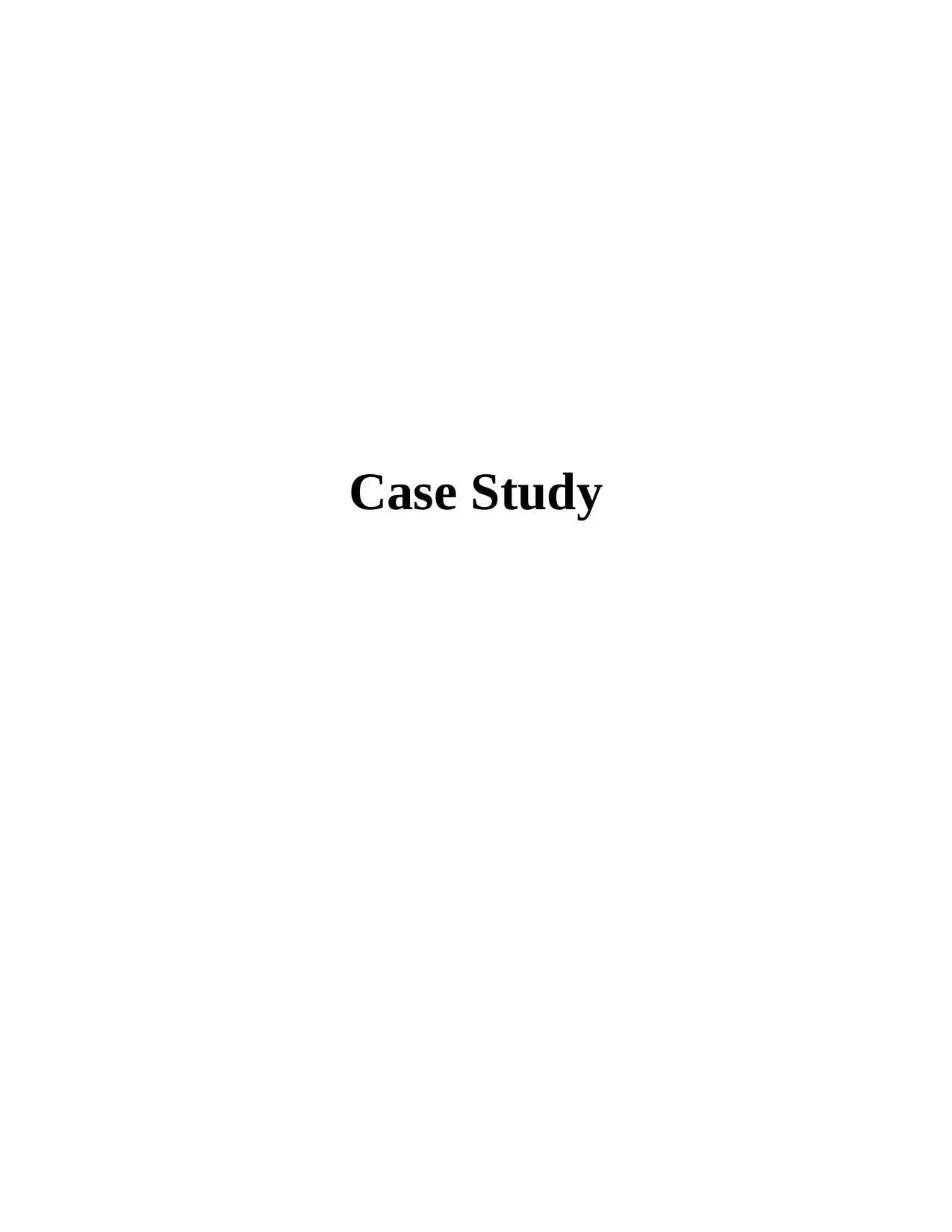
Case Study
Paraphrase This Document
Need a fresh take? Get an instant paraphrase of this document with our AI Paraphraser
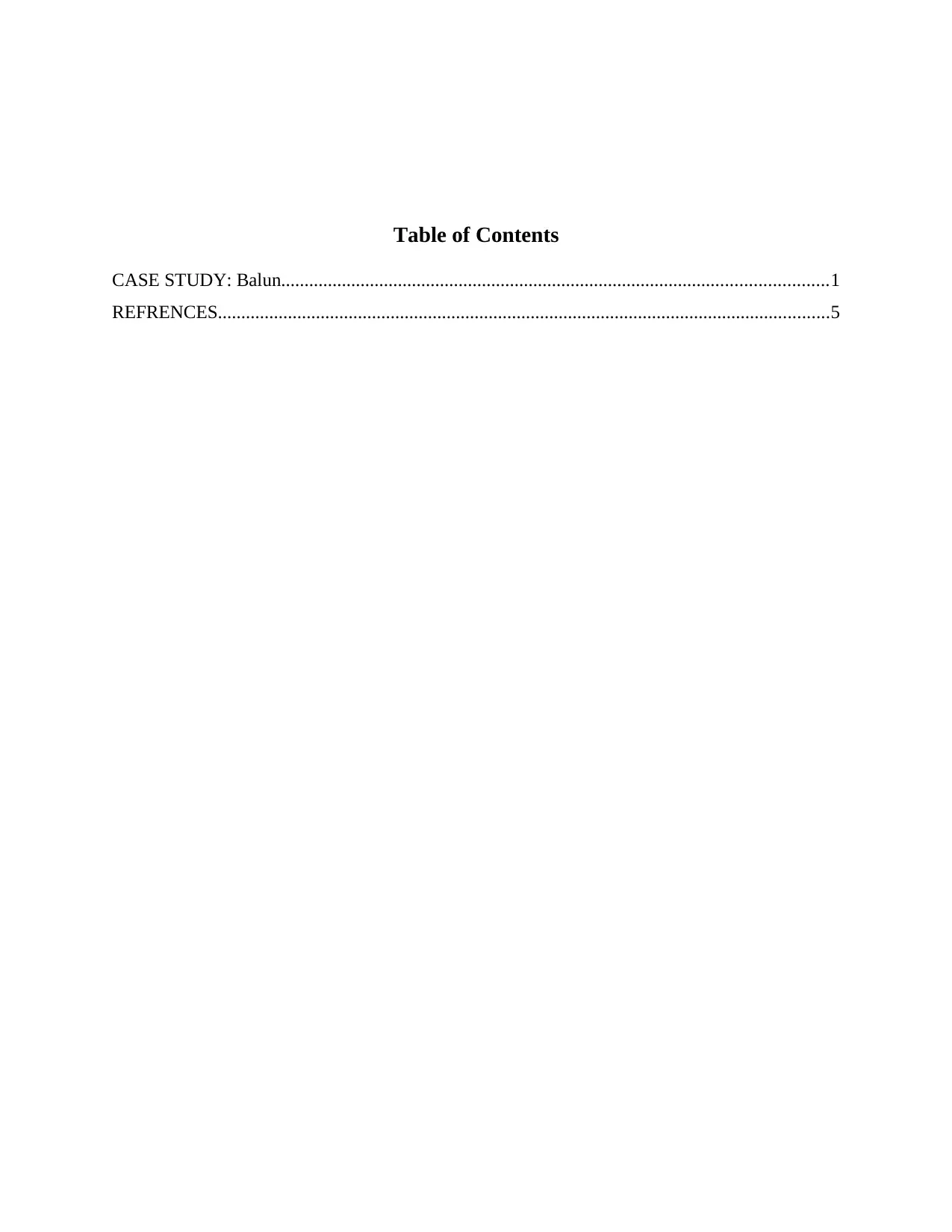
Table of Contents
CASE STUDY: Balun.....................................................................................................................1
REFRENCES...................................................................................................................................5
CASE STUDY: Balun.....................................................................................................................1
REFRENCES...................................................................................................................................5
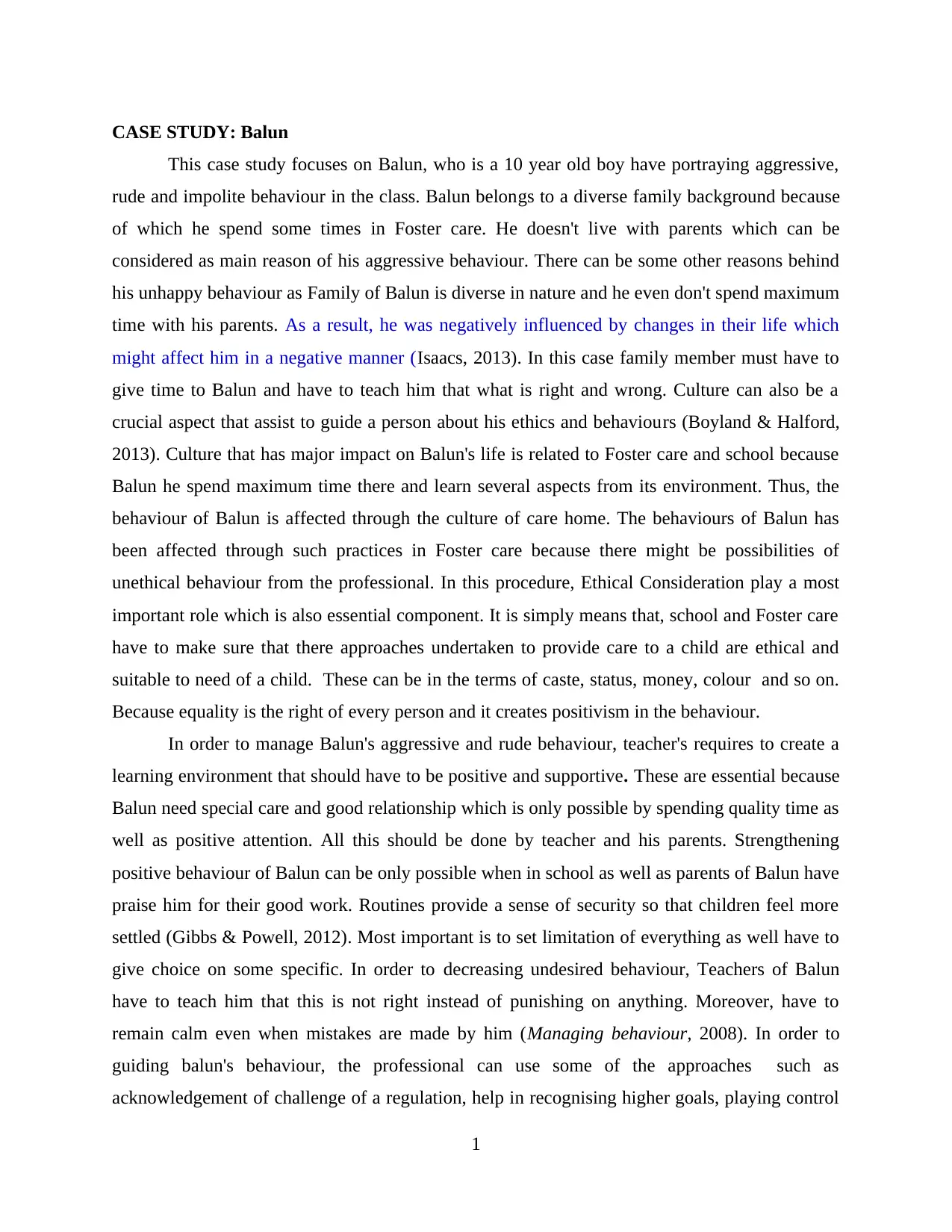
CASE STUDY: Balun
This case study focuses on Balun, who is a 10 year old boy have portraying aggressive,
rude and impolite behaviour in the class. Balun belongs to a diverse family background because
of which he spend some times in Foster care. He doesn't live with parents which can be
considered as main reason of his aggressive behaviour. There can be some other reasons behind
his unhappy behaviour as Family of Balun is diverse in nature and he even don't spend maximum
time with his parents. As a result, he was negatively influenced by changes in their life which
might affect him in a negative manner (Isaacs, 2013). In this case family member must have to
give time to Balun and have to teach him that what is right and wrong. Culture can also be a
crucial aspect that assist to guide a person about his ethics and behaviours (Boyland & Halford,
2013). Culture that has major impact on Balun's life is related to Foster care and school because
Balun he spend maximum time there and learn several aspects from its environment. Thus, the
behaviour of Balun is affected through the culture of care home. The behaviours of Balun has
been affected through such practices in Foster care because there might be possibilities of
unethical behaviour from the professional. In this procedure, Ethical Consideration play a most
important role which is also essential component. It is simply means that, school and Foster care
have to make sure that there approaches undertaken to provide care to a child are ethical and
suitable to need of a child. These can be in the terms of caste, status, money, colour and so on.
Because equality is the right of every person and it creates positivism in the behaviour.
In order to manage Balun's aggressive and rude behaviour, teacher's requires to create a
learning environment that should have to be positive and supportive. These are essential because
Balun need special care and good relationship which is only possible by spending quality time as
well as positive attention. All this should be done by teacher and his parents. Strengthening
positive behaviour of Balun can be only possible when in school as well as parents of Balun have
praise him for their good work. Routines provide a sense of security so that children feel more
settled (Gibbs & Powell, 2012). Most important is to set limitation of everything as well have to
give choice on some specific. In order to decreasing undesired behaviour, Teachers of Balun
have to teach him that this is not right instead of punishing on anything. Moreover, have to
remain calm even when mistakes are made by him (Managing behaviour, 2008). In order to
guiding balun's behaviour, the professional can use some of the approaches such as
acknowledgement of challenge of a regulation, help in recognising higher goals, playing control
1
This case study focuses on Balun, who is a 10 year old boy have portraying aggressive,
rude and impolite behaviour in the class. Balun belongs to a diverse family background because
of which he spend some times in Foster care. He doesn't live with parents which can be
considered as main reason of his aggressive behaviour. There can be some other reasons behind
his unhappy behaviour as Family of Balun is diverse in nature and he even don't spend maximum
time with his parents. As a result, he was negatively influenced by changes in their life which
might affect him in a negative manner (Isaacs, 2013). In this case family member must have to
give time to Balun and have to teach him that what is right and wrong. Culture can also be a
crucial aspect that assist to guide a person about his ethics and behaviours (Boyland & Halford,
2013). Culture that has major impact on Balun's life is related to Foster care and school because
Balun he spend maximum time there and learn several aspects from its environment. Thus, the
behaviour of Balun is affected through the culture of care home. The behaviours of Balun has
been affected through such practices in Foster care because there might be possibilities of
unethical behaviour from the professional. In this procedure, Ethical Consideration play a most
important role which is also essential component. It is simply means that, school and Foster care
have to make sure that there approaches undertaken to provide care to a child are ethical and
suitable to need of a child. These can be in the terms of caste, status, money, colour and so on.
Because equality is the right of every person and it creates positivism in the behaviour.
In order to manage Balun's aggressive and rude behaviour, teacher's requires to create a
learning environment that should have to be positive and supportive. These are essential because
Balun need special care and good relationship which is only possible by spending quality time as
well as positive attention. All this should be done by teacher and his parents. Strengthening
positive behaviour of Balun can be only possible when in school as well as parents of Balun have
praise him for their good work. Routines provide a sense of security so that children feel more
settled (Gibbs & Powell, 2012). Most important is to set limitation of everything as well have to
give choice on some specific. In order to decreasing undesired behaviour, Teachers of Balun
have to teach him that this is not right instead of punishing on anything. Moreover, have to
remain calm even when mistakes are made by him (Managing behaviour, 2008). In order to
guiding balun's behaviour, the professional can use some of the approaches such as
acknowledgement of challenge of a regulation, help in recognising higher goals, playing control
1
⊘ This is a preview!⊘
Do you want full access?
Subscribe today to unlock all pages.

Trusted by 1+ million students worldwide
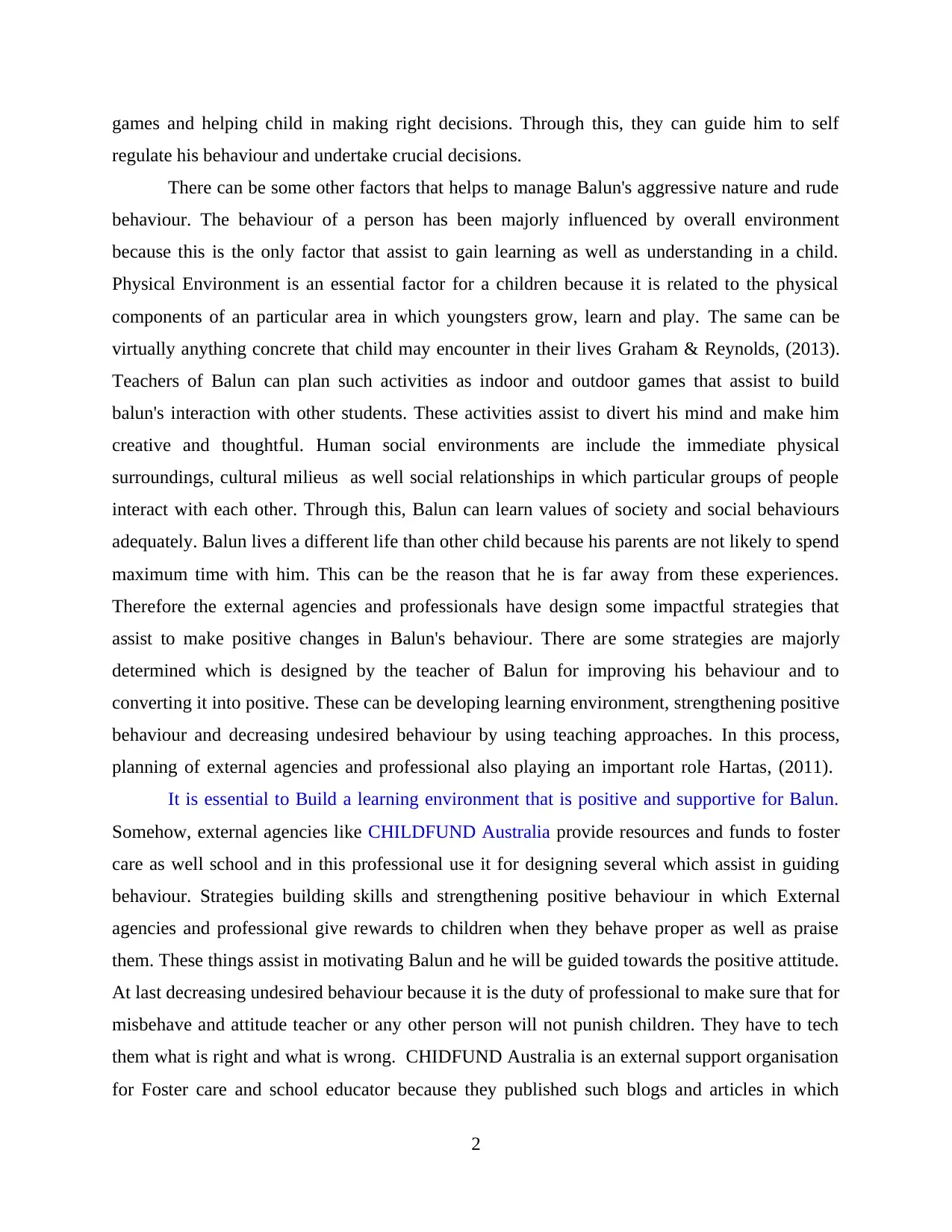
games and helping child in making right decisions. Through this, they can guide him to self
regulate his behaviour and undertake crucial decisions.
There can be some other factors that helps to manage Balun's aggressive nature and rude
behaviour. The behaviour of a person has been majorly influenced by overall environment
because this is the only factor that assist to gain learning as well as understanding in a child.
Physical Environment is an essential factor for a children because it is related to the physical
components of an particular area in which youngsters grow, learn and play. The same can be
virtually anything concrete that child may encounter in their lives Graham & Reynolds, (2013).
Teachers of Balun can plan such activities as indoor and outdoor games that assist to build
balun's interaction with other students. These activities assist to divert his mind and make him
creative and thoughtful. Human social environments are include the immediate physical
surroundings, cultural milieus as well social relationships in which particular groups of people
interact with each other. Through this, Balun can learn values of society and social behaviours
adequately. Balun lives a different life than other child because his parents are not likely to spend
maximum time with him. This can be the reason that he is far away from these experiences.
Therefore the external agencies and professionals have design some impactful strategies that
assist to make positive changes in Balun's behaviour. There are some strategies are majorly
determined which is designed by the teacher of Balun for improving his behaviour and to
converting it into positive. These can be developing learning environment, strengthening positive
behaviour and decreasing undesired behaviour by using teaching approaches. In this process,
planning of external agencies and professional also playing an important role Hartas, (2011).
It is essential to Build a learning environment that is positive and supportive for Balun.
Somehow, external agencies like CHILDFUND Australia provide resources and funds to foster
care as well school and in this professional use it for designing several which assist in guiding
behaviour. Strategies building skills and strengthening positive behaviour in which External
agencies and professional give rewards to children when they behave proper as well as praise
them. These things assist in motivating Balun and he will be guided towards the positive attitude.
At last decreasing undesired behaviour because it is the duty of professional to make sure that for
misbehave and attitude teacher or any other person will not punish children. They have to tech
them what is right and what is wrong. CHIDFUND Australia is an external support organisation
for Foster care and school educator because they published such blogs and articles in which
2
regulate his behaviour and undertake crucial decisions.
There can be some other factors that helps to manage Balun's aggressive nature and rude
behaviour. The behaviour of a person has been majorly influenced by overall environment
because this is the only factor that assist to gain learning as well as understanding in a child.
Physical Environment is an essential factor for a children because it is related to the physical
components of an particular area in which youngsters grow, learn and play. The same can be
virtually anything concrete that child may encounter in their lives Graham & Reynolds, (2013).
Teachers of Balun can plan such activities as indoor and outdoor games that assist to build
balun's interaction with other students. These activities assist to divert his mind and make him
creative and thoughtful. Human social environments are include the immediate physical
surroundings, cultural milieus as well social relationships in which particular groups of people
interact with each other. Through this, Balun can learn values of society and social behaviours
adequately. Balun lives a different life than other child because his parents are not likely to spend
maximum time with him. This can be the reason that he is far away from these experiences.
Therefore the external agencies and professionals have design some impactful strategies that
assist to make positive changes in Balun's behaviour. There are some strategies are majorly
determined which is designed by the teacher of Balun for improving his behaviour and to
converting it into positive. These can be developing learning environment, strengthening positive
behaviour and decreasing undesired behaviour by using teaching approaches. In this process,
planning of external agencies and professional also playing an important role Hartas, (2011).
It is essential to Build a learning environment that is positive and supportive for Balun.
Somehow, external agencies like CHILDFUND Australia provide resources and funds to foster
care as well school and in this professional use it for designing several which assist in guiding
behaviour. Strategies building skills and strengthening positive behaviour in which External
agencies and professional give rewards to children when they behave proper as well as praise
them. These things assist in motivating Balun and he will be guided towards the positive attitude.
At last decreasing undesired behaviour because it is the duty of professional to make sure that for
misbehave and attitude teacher or any other person will not punish children. They have to tech
them what is right and what is wrong. CHIDFUND Australia is an external support organisation
for Foster care and school educator because they published such blogs and articles in which
2
Paraphrase This Document
Need a fresh take? Get an instant paraphrase of this document with our AI Paraphraser
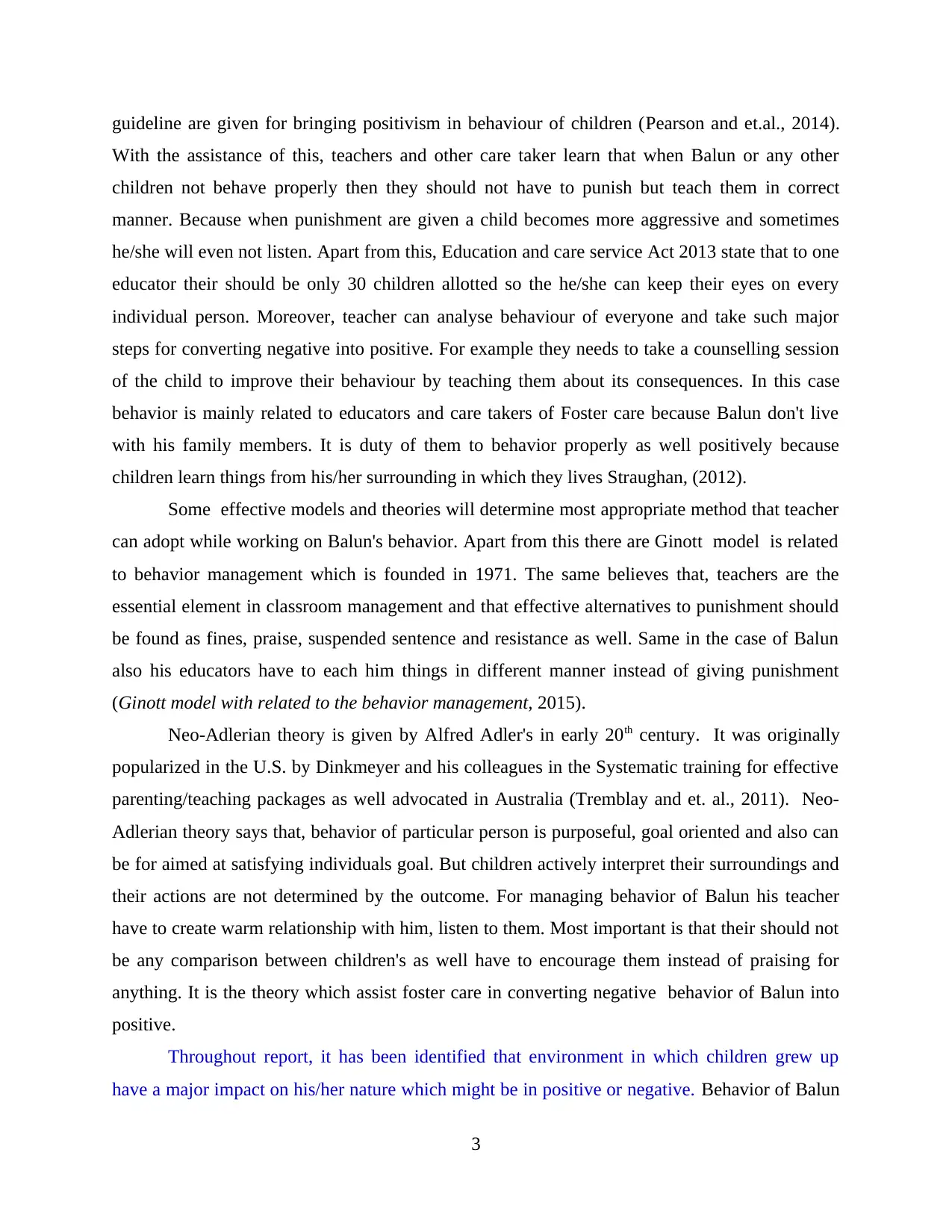
guideline are given for bringing positivism in behaviour of children (Pearson and et.al., 2014).
With the assistance of this, teachers and other care taker learn that when Balun or any other
children not behave properly then they should not have to punish but teach them in correct
manner. Because when punishment are given a child becomes more aggressive and sometimes
he/she will even not listen. Apart from this, Education and care service Act 2013 state that to one
educator their should be only 30 children allotted so the he/she can keep their eyes on every
individual person. Moreover, teacher can analyse behaviour of everyone and take such major
steps for converting negative into positive. For example they needs to take a counselling session
of the child to improve their behaviour by teaching them about its consequences. In this case
behavior is mainly related to educators and care takers of Foster care because Balun don't live
with his family members. It is duty of them to behavior properly as well positively because
children learn things from his/her surrounding in which they lives Straughan, (2012).
Some effective models and theories will determine most appropriate method that teacher
can adopt while working on Balun's behavior. Apart from this there are Ginott model is related
to behavior management which is founded in 1971. The same believes that, teachers are the
essential element in classroom management and that effective alternatives to punishment should
be found as fines, praise, suspended sentence and resistance as well. Same in the case of Balun
also his educators have to each him things in different manner instead of giving punishment
(Ginott model with related to the behavior management, 2015).
Neo-Adlerian theory is given by Alfred Adler's in early 20th century. It was originally
popularized in the U.S. by Dinkmeyer and his colleagues in the Systematic training for effective
parenting/teaching packages as well advocated in Australia (Tremblay and et. al., 2011). Neo-
Adlerian theory says that, behavior of particular person is purposeful, goal oriented and also can
be for aimed at satisfying individuals goal. But children actively interpret their surroundings and
their actions are not determined by the outcome. For managing behavior of Balun his teacher
have to create warm relationship with him, listen to them. Most important is that their should not
be any comparison between children's as well have to encourage them instead of praising for
anything. It is the theory which assist foster care in converting negative behavior of Balun into
positive.
Throughout report, it has been identified that environment in which children grew up
have a major impact on his/her nature which might be in positive or negative. Behavior of Balun
3
With the assistance of this, teachers and other care taker learn that when Balun or any other
children not behave properly then they should not have to punish but teach them in correct
manner. Because when punishment are given a child becomes more aggressive and sometimes
he/she will even not listen. Apart from this, Education and care service Act 2013 state that to one
educator their should be only 30 children allotted so the he/she can keep their eyes on every
individual person. Moreover, teacher can analyse behaviour of everyone and take such major
steps for converting negative into positive. For example they needs to take a counselling session
of the child to improve their behaviour by teaching them about its consequences. In this case
behavior is mainly related to educators and care takers of Foster care because Balun don't live
with his family members. It is duty of them to behavior properly as well positively because
children learn things from his/her surrounding in which they lives Straughan, (2012).
Some effective models and theories will determine most appropriate method that teacher
can adopt while working on Balun's behavior. Apart from this there are Ginott model is related
to behavior management which is founded in 1971. The same believes that, teachers are the
essential element in classroom management and that effective alternatives to punishment should
be found as fines, praise, suspended sentence and resistance as well. Same in the case of Balun
also his educators have to each him things in different manner instead of giving punishment
(Ginott model with related to the behavior management, 2015).
Neo-Adlerian theory is given by Alfred Adler's in early 20th century. It was originally
popularized in the U.S. by Dinkmeyer and his colleagues in the Systematic training for effective
parenting/teaching packages as well advocated in Australia (Tremblay and et. al., 2011). Neo-
Adlerian theory says that, behavior of particular person is purposeful, goal oriented and also can
be for aimed at satisfying individuals goal. But children actively interpret their surroundings and
their actions are not determined by the outcome. For managing behavior of Balun his teacher
have to create warm relationship with him, listen to them. Most important is that their should not
be any comparison between children's as well have to encourage them instead of praising for
anything. It is the theory which assist foster care in converting negative behavior of Balun into
positive.
Throughout report, it has been identified that environment in which children grew up
have a major impact on his/her nature which might be in positive or negative. Behavior of Balun
3
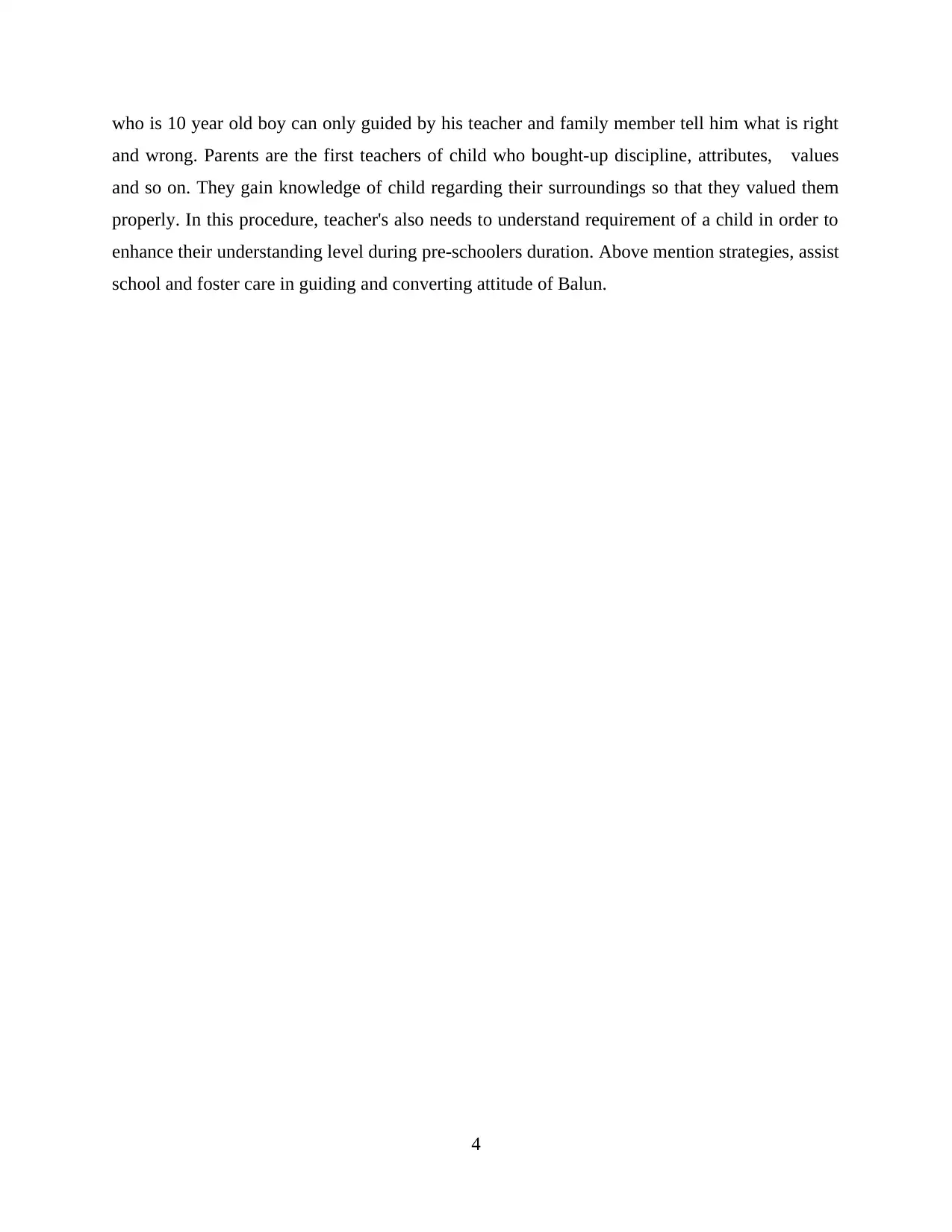
who is 10 year old boy can only guided by his teacher and family member tell him what is right
and wrong. Parents are the first teachers of child who bought-up discipline, attributes, values
and so on. They gain knowledge of child regarding their surroundings so that they valued them
properly. In this procedure, teacher's also needs to understand requirement of a child in order to
enhance their understanding level during pre-schoolers duration. Above mention strategies, assist
school and foster care in guiding and converting attitude of Balun.
4
and wrong. Parents are the first teachers of child who bought-up discipline, attributes, values
and so on. They gain knowledge of child regarding their surroundings so that they valued them
properly. In this procedure, teacher's also needs to understand requirement of a child in order to
enhance their understanding level during pre-schoolers duration. Above mention strategies, assist
school and foster care in guiding and converting attitude of Balun.
4
⊘ This is a preview!⊘
Do you want full access?
Subscribe today to unlock all pages.

Trusted by 1+ million students worldwide
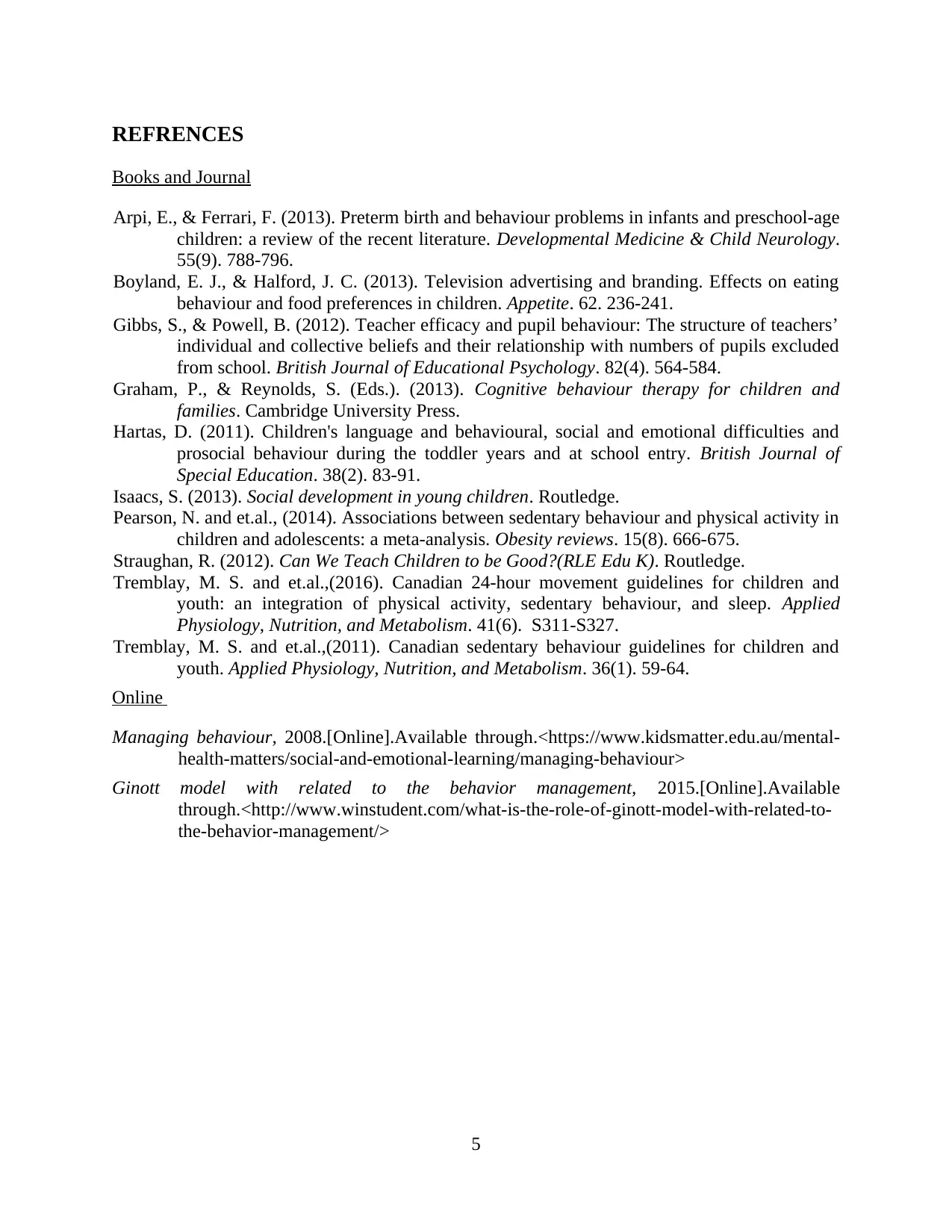
REFRENCES
Books and Journal
Arpi, E., & Ferrari, F. (2013). Preterm birth and behaviour problems in infants and preschool‐age
children: a review of the recent literature. Developmental Medicine & Child Neurology.
55(9). 788-796.
Boyland, E. J., & Halford, J. C. (2013). Television advertising and branding. Effects on eating
behaviour and food preferences in children. Appetite. 62. 236-241.
Gibbs, S., & Powell, B. (2012). Teacher efficacy and pupil behaviour: The structure of teachers’
individual and collective beliefs and their relationship with numbers of pupils excluded
from school. British Journal of Educational Psychology. 82(4). 564-584.
Graham, P., & Reynolds, S. (Eds.). (2013). Cognitive behaviour therapy for children and
families. Cambridge University Press.
Hartas, D. (2011). Children's language and behavioural, social and emotional difficulties and
prosocial behaviour during the toddler years and at school entry. British Journal of
Special Education. 38(2). 83-91.
Isaacs, S. (2013). Social development in young children. Routledge.
Pearson, N. and et.al., (2014). Associations between sedentary behaviour and physical activity in
children and adolescents: a meta‐analysis. Obesity reviews. 15(8). 666-675.
Straughan, R. (2012). Can We Teach Children to be Good?(RLE Edu K). Routledge.
Tremblay, M. S. and et.al.,(2016). Canadian 24-hour movement guidelines for children and
youth: an integration of physical activity, sedentary behaviour, and sleep. Applied
Physiology, Nutrition, and Metabolism. 41(6). S311-S327.
Tremblay, M. S. and et.al.,(2011). Canadian sedentary behaviour guidelines for children and
youth. Applied Physiology, Nutrition, and Metabolism. 36(1). 59-64.
Online
Managing behaviour, 2008.[Online].Available through.<https://www.kidsmatter.edu.au/mental-
health-matters/social-and-emotional-learning/managing-behaviour>
Ginott model with related to the behavior management, 2015.[Online].Available
through.<http://www.winstudent.com/what-is-the-role-of-ginott-model-with-related-to-
the-behavior-management/>
5
Books and Journal
Arpi, E., & Ferrari, F. (2013). Preterm birth and behaviour problems in infants and preschool‐age
children: a review of the recent literature. Developmental Medicine & Child Neurology.
55(9). 788-796.
Boyland, E. J., & Halford, J. C. (2013). Television advertising and branding. Effects on eating
behaviour and food preferences in children. Appetite. 62. 236-241.
Gibbs, S., & Powell, B. (2012). Teacher efficacy and pupil behaviour: The structure of teachers’
individual and collective beliefs and their relationship with numbers of pupils excluded
from school. British Journal of Educational Psychology. 82(4). 564-584.
Graham, P., & Reynolds, S. (Eds.). (2013). Cognitive behaviour therapy for children and
families. Cambridge University Press.
Hartas, D. (2011). Children's language and behavioural, social and emotional difficulties and
prosocial behaviour during the toddler years and at school entry. British Journal of
Special Education. 38(2). 83-91.
Isaacs, S. (2013). Social development in young children. Routledge.
Pearson, N. and et.al., (2014). Associations between sedentary behaviour and physical activity in
children and adolescents: a meta‐analysis. Obesity reviews. 15(8). 666-675.
Straughan, R. (2012). Can We Teach Children to be Good?(RLE Edu K). Routledge.
Tremblay, M. S. and et.al.,(2016). Canadian 24-hour movement guidelines for children and
youth: an integration of physical activity, sedentary behaviour, and sleep. Applied
Physiology, Nutrition, and Metabolism. 41(6). S311-S327.
Tremblay, M. S. and et.al.,(2011). Canadian sedentary behaviour guidelines for children and
youth. Applied Physiology, Nutrition, and Metabolism. 36(1). 59-64.
Online
Managing behaviour, 2008.[Online].Available through.<https://www.kidsmatter.edu.au/mental-
health-matters/social-and-emotional-learning/managing-behaviour>
Ginott model with related to the behavior management, 2015.[Online].Available
through.<http://www.winstudent.com/what-is-the-role-of-ginott-model-with-related-to-
the-behavior-management/>
5
1 out of 7
Related Documents
Your All-in-One AI-Powered Toolkit for Academic Success.
+13062052269
info@desklib.com
Available 24*7 on WhatsApp / Email
![[object Object]](/_next/static/media/star-bottom.7253800d.svg)
Unlock your academic potential
Copyright © 2020–2025 A2Z Services. All Rights Reserved. Developed and managed by ZUCOL.




